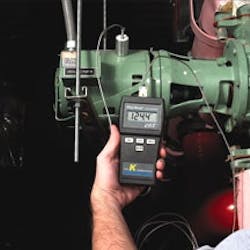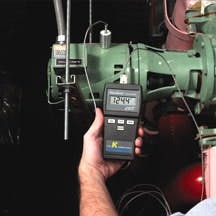Handheld temperature measurement devices are a must-have for every manufacturing plant
Temperature is an important variable for manufacturing, quality control and maintenance. Monitoring an object's temperature helps ensure a process is operating consistently under conditions that optimize product quality, increase productivity and reduce downtime.
Temperature can be measured using a variety of sensor types. Some of the more common types found in manufacturing plants are thermocouples and resistive temperature devices (RTDs), contact sensors and infrared non-contact devices.
Thermocouples
The quintessential contact measurement device is the thermocouple. It consists of two wires of dissimilar metal fused at their ends. The predictable relationship between the junction's temperature and the voltage it produces permits a thermocouple thermometer to measure, interpret and display the signal as a temperature.
Thermocouples can be fabricated from different metals, and a single letter designates each combination. Choosing the correct thermocouple type depends on the application's temperature range and the required accuracy. Thermocouples offer the advantage of a wide temperature measuring range (-450 F to 2,700 F).
Resistive temperature device
RTD sensors are constructed of a metal wire, the electrical resistance of which is a function of temperature. An RTD thermometer measures and interprets the wire's resistance and displays a temperature equivalent. In theory, the RTD wire can be made of any metal, but repeatability, stability and resistance to corrosion and chemicals make platinum the metal of choice. RTDs offer high accuracy and repeatability, but have a limited temperature range of -58 F to 1,562 F.
Non-contact measurement
Any object emits infrared energy. The hotter the object, the more active its molecules, and the more infrared energy it emits. An infrared thermometer senses an object's emitted, reflected and transmitted energy, which passes through the thermometer's optical system, where it's converted to an electrical signal for display as a temperature reading.
Infrared thermometers offer advantages over contact thermometers, because they can measure temperature without touching the object being measured. Infrared measurement is ideal for measuring the temperature of objects that:
Are hard to reach.
May contaminate the sensor.
Are moving.
Require more rapid temperature measurements than contact sensors can provide.
Have temperatures to 3,000 F.
Can be scratched or damaged by physical contact.
Have curved, distorted or varying surfaces.
Are too thin and soft for contact sensors.
Are too hot to touch or approach.
Are electrically active or otherwise too dangerous to touch.
Temperature measurement applications
Measuring and interpreting temperature has many MRO applications. Measurements throughout the plant can be done quickly and easily and without complex analysis. One can check and record many measurements around the plant quickly. This information then can be stored electronically for later data trend analysis.
For example, consider plant wiring. Anytime electrical current flows through cables and connections, ohmic resistance generates heat. Increased current flow through a cable generates more heat. If two similar sized cables have different temperatures, one can conclude the hotter cable carries the higher current. Resistance and heat build-up also occur at defective wiring connections.
Some typical applications for technicians and service personnel are:
Watching bearing temperature.
Detecting motor overload.
Finding defective transformers.
Detecting loose and improper wiring connections.
Checking electrical panels for hot spots.
Measuring the surface of ductwork to reveal temperature variations, poor insulation or duct leakage.
Diagnosing blown or plugged steam traps from a safe distance.
Checking flue temperature.
Evaluating temperature differences between supply/return registers in the HVAC system.
Checking for coil sweating on condensate lines in refrigeration systems.
Checking the temperature of emergency relief valves.
Diagnosing water leaks by measuring wallboard temperature.
Pete Leal is product manager at Cole Parmer. He can be reached at pleal@coleparmer.com or
847-327-5860

